URIDINE DOSAGE AND USE

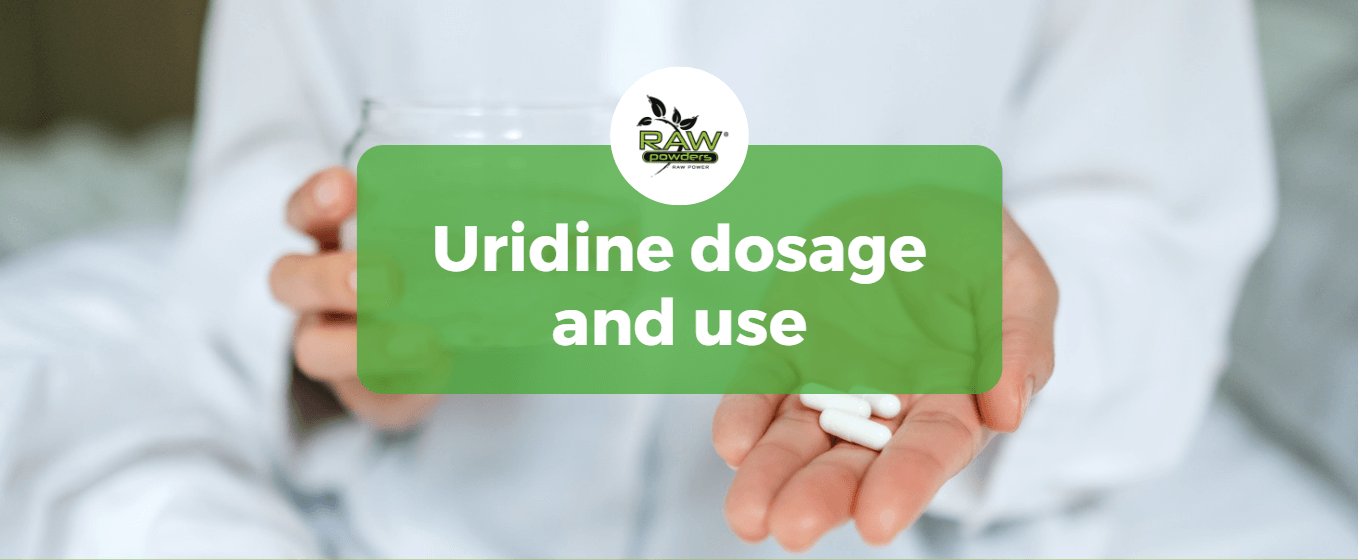
There are no official dosage recommendations for uridine supplements. Unofficial dosages are based on clinical studies and range from 1 g/day to 2 g/day. This amount is usually divided into several doses per day.
Uridine is a nucleotide component, or RNA component, that is receiving increasing interest because of its potential health benefits. (For more information on the benefits of uridine, see here.) As this compound is naturally occurring in the human body, as well as in certain foods, it is important to understand the sources, the potential therapeutic doses and the circumstances in which it may be beneficial.
Uridine is one of the essential nutrients in organisms. To maintain normal cell growth and intracellular metabolism, the uridine must be maintained at a certain concentration. Recent studies have shown that uridine can reduce inflammatory response in organisms, participate in glycolysis, and regulate intracellular protein modification, such as glycosylation and acetylation. Furthermore, it can protect cells from hypoxic injury by reducing intracellular oxidative stress, promoting high-energy compounds synthesis [1].
Also during rapid cell growth the availability of phospholipid precursors like cytidine triphosphate and diacylglycerol can become limiting in the formation of key membrane constituents like phosphatidylcholine. Uridine, a normal plasma constituent, can be converted to cytidine triphosphate in PC12 cells and intact brain, and has been shown to produce a resulting increase in phosphatidylcholine synthesis [2].
Natural sources and dietary considerations
Uridine is present in several food sources such as nutritional and brewer's yeast, certain vegetables such as mushrooms and broccoli, organic meats such as liver, fish and even beer. Babies get a lot of uridine in their breast milk, which is essential for their brain development. However, studies show that dietary uridine in its RNA form is not bioavailable because it is broken down in the gastrointestinal tract and liver. Therefore, those with a high need for uridine may want to consider supplementation in consultation with their health care provider.
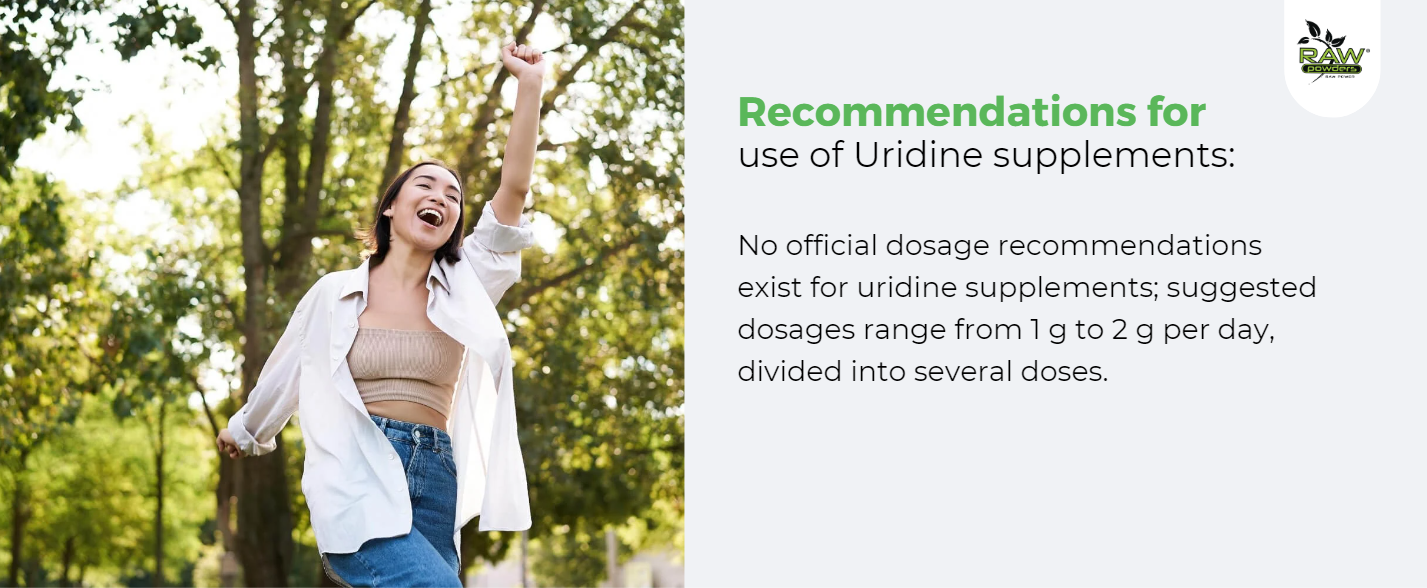
Recommended dosage of uridine
There is no official dosage for uridine supplements as they are not approved for the treatment of any medical conditions. Unofficial dosages have been established in clinical trials and range from 1 g/day for depressed adolescents to 2 g/day for healthy adults. These doses are usually divided into several doses per day. Most supplements contain 200-350 mg per capsule, usually in the form of uridine monophosphate (UMP). However, due to safety concerns observed in long-term animal studies, long-term uridine supplementation is not recommended [3, 4].
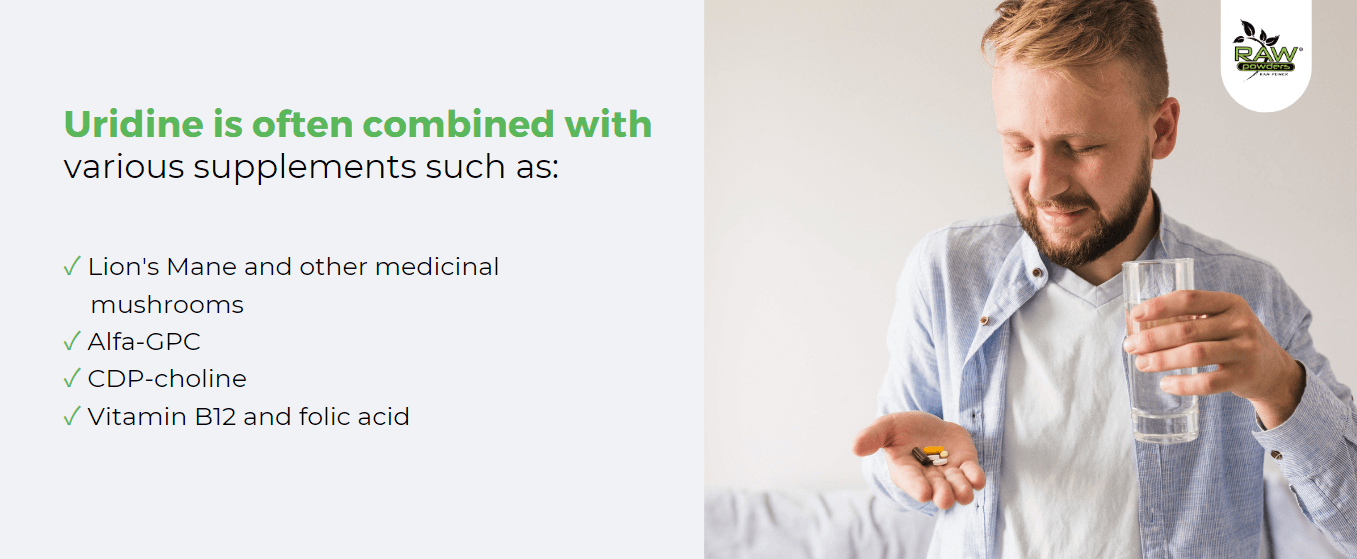
Combinations of uridine supplements
Uridine is often combined with various supplements, although there is little or no reliable evidence to support the effectiveness of such combinations. The FDA (Food and Drug Administration, USA) has not approved these dietary supplements for the treatment of any medical condition, and although there are manufacturing regulations, these do not guarantee safety or efficacy. Before taking any supplement, a healthcare provider should be consulted to avoid potentially dangerous interactions.
1. Uridine in medicinal mushrooms
- Interestingly, some mushrooms naturally contain uridine. The giant oyster mushroom, which grows in Malaysia and is traditionally used in local cuisine, has recently been found to be a rich source of uridine and other brain-health-boosting antioxidants [5]. Both giant oyster mushrooms and other species such as lion’s mane and tiger milk mushrooms have been found to promote neurite outgrowth, help regenerate nerve cells and increase the levels of nerve growth factor, which is essential for brain vitality. It was shown that in Pleurotus (oyster mushroom) one of the key bioactive molecules responsible for neurite outgrowth is uridine [6].
- The presence of uridine in lion's mane mushrooms has not yet been confirmed, but the possible cognitive benefits of this mushroom are being investigated.
- Of all the mushrooms tested, the puffball mushroom (Lasiosphaeria sp.) had the highest amount of adenosine and uridine. From wild edible mushrooms uridine and xanthosine were found to be the highest in Entoloma saundersii [7].
2. Combination of Uridine with other supplemental ingredients
- Alpha-GPC, a dietary supplement containing choline that increases levels of acetylcholine, a neurotransmitter vital for memory and learning. Uridine has the potential to enhance the effects of alpha-GPC, since the synthesis of certain brain phospholipids depends on sufficient choline and uridine.
The combination of uridine and choline bitartrate or CDP-choline supplementation is also based on this reason. In humans oral CDP-choline also increases plasma levels of uridine due to its role as a source of cytidine, which is partly converted to uridine. Cytidine is rapidly metabolized to cytidine diphosphate and cytidine triphosphate more efficiently than uridine. However, it also converts less extensively to RNA uridylic acid compared to uridine [8, 9, 10, 11].
- Animal studies have shown that uridine combined with DHA (an omega-3 fatty acid) and choline can increase the number of brain synapses [12].
- DHA may promote neuronal membrane synthesis to increase the number of synapses, particularly when co-administered with UMP [13].
- As uridine and choline work synergistically with DHA to increase phosphatidylcholine formation, there is a compelling rationale to combine these nutrients. A multinutrient supplement enriched with uridine, choline, and DHA has been evaluated in randomized controlled trials to support brain function [14, 15, 16, 17].
- Another study reported the results of low back pain treatment using a combination of nucleotides, uridine (UTP), cytidine (CMP) and vitamin B12, vs a combination of vitamins B1, B6, and B12. Treatment with nucleotides+B12 was associated with a lower number of total adverse events (AEs), fewer AEs per subject, and no AE-related treatment discontinuation. Pain intensity reduction was superior at 30 days of treatment in the nucleotides+B12 group and equivalent between groups at 60 days of treatment [18].
- On the other hand, on the basis of results of another study, it is concluded that the combination of UTP, CMP, and hydroxocobalamin did not influence recovery from neurosensory disorders [19].
- In one study it was also shown that a combination of uridine, cytidine, and vitamin B12 was safe and effective in the treatment of neuralgias arising from neural compression associated with degenerative orthopedic alterations and trauma [20].
- A clinical study found that a special combination of uridine monophosphate, vitamin B12 and folic acid reduced nerve pain over two months. This combination consisted of 50 mg of uridine monophosphate per day, 3 mcg of vitamin B12 per day and 400 mcg of folic acid per day [21].
- The aim of another pilot study was to investigate the effect of combining a motor- and cognitive exercise program with dietary supplementation consisting of 500 mg docosahexaenoic acid (DHA), 10 μg vitamin D3 and 1000 mg uridine (DDU-supplement) in 16 prepubescent children (age 8-11 years). All children showed improved performance in the trained motor- and cognitive tasks, but it was not possible to demonstrate any significant effects on the cognitive tests from the dietary supplementation. However, DDU-supplementation did result in increased blood concentration of DHA and vitamin D2+3 [22].
3. Increasing dopamine levels
- In animal studies it was shown that dietary uridine-5′-monophosphate supplementation increases potassium-evoked dopamine release and promotes neurite outgrowth [23].
- Antiepileptic effect of uridine may be caused by regulating dopamine release and receptor expression in corpus striatum [24].
How to take uridine monophosphate
- Pure: 500 mg-1000 mg of uridine per day is the typical dose that is recommended by manufacturers and has been shown to have cognitive effects.
- In combination with a choline supplement: Several studies say about the efficacy of combination uridine with choline or/and cytidine sources). , e.g. 500 mg CDP choline + 500 mg uridine.
- Know your limits: Too much uridine can cause diarrhea and fever.
- Don't drink too much coffee: Some users report that taking uridine supplements and drinking a lot of coffee can lead to increased irritability.
Safety and monitoring
Whatever the circumstances, it is very important to follow your doctor's recommendations when taking uridine, especially in the absence of detailed data on renal or hepatic reactions and dose adjustments.
Although uridine offers interesting possibilities for cognitive enhancement and therapeutic intervention, it is important to understand its sources, appropriate doses and the nuances of administration. Like any other supplement or medicine, it should be used responsibly and under the guidance of a healthcare professional to ensure safety and efficacy.
Effects of short-term oral administrations of uridine were investigated for example in a study of six healthy volunteer control subjects and nine patients with metastatic colorectal cancer. In this study the maximum tolerated dose (MTD) was 10 to 12 g/m2 for a single dose of uridine and 5 g/m2 for the multiple-dose regimen. Diarrhea was the dose-limiting toxic effect [25].
The safety profile of uridine, particularly for long-term use, is not well established. Animal studies have raised doubts about the safety of long-term use of uridine, indicating potential risks that should be carefully considered by anyone wishing to supplement with uridine.
Healthcare providers recommend monitoring uridine intake, especially in the case of therapeutic use, for example in diseases such as hereditary orthostatic aciduria*, where doses need to be adjusted according to efficacy and symptomatology. Patients taking uridine triacetate for medical conditions should follow the recommended laboratory monitoring to ensure therapeutic efficacy and to check for potential side effects.
More about the side effects of uridine you will find here.
The role of uridine as a nootropic substance remains an area of interest with promising implications for improving cognitive function and treating certain mood disorders. Its therapeutic applications for specific medical conditions are well defined and clinically established. However, the wider use of uridine as a dietary supplement requires careful consideration of the available research, an understanding of the limitations of current knowledge and a prioritization of safety, in consultation with medical professionals and monitoring. As the scientific community continues to investigate uridine, it is likely that our understanding of its optimal use and its full potential will continue to improve.
* Orthostatic aciduria is a condition in which the body's uric acid concentration increases when a person is in an upright position (standing). This phenomenon is usually associated with certain physiological or pathological conditions. Orthostatic aciduria can result from physiological changes in the physiology of the urinary tract system, such as changes in body position, or from certain non-specific conditions in the body, such as dehydration or excessive physical exercise.
Medical Disclaimer
The information provided in our articles is solely for educational purposes and should not be considered medical advice or instruction. No action or inaction should be taken based solely on the contents of this information. Readers should consult their health care professional on any matter related to their health and well-being. The information and opinions provided here are believed to be accurate and sound, based on the best judgment available to the authors, but readers who fail to consult with appropriate health authorities assume the risk of any injuries. The publisher is not responsible for errors or omissions.
Please be aware that different countries may have specific regulations and that this disclaimer does not replace the need for consultation with a healthcare provider before beginning or changing a treatment or supplement regimen. The information contained in this article is not intended to diagnose, treat, cure, or prevent any disease. Individual results may vary.
References
- Xueyi Bai, Ding Huang, Pan Xie, Ruiqiang Sun, Hang Zhou, Yu Liu. Effect of uridine on mitochondrial function. Review Sheng Wu Gong Cheng Xue Bao. 2023 Sep 25;39(9):3695-3709. doi: 10.13345/j.cjb.220899. PMID: 37805847. https://pubmed.ncbi.nlm.nih.gov/37805847/
- A. M. Pooler, D. H. Guez, R. Benedictus, R. J. Wurtman. Uridine enhances neurite outgrowth in nerve growth factor-differentiated PC12. Comparative Study Neuroscience. 2005;134(1):207-14. doi: 10.1016/j.neuroscience.2005.03.050. PMID: 15939540. https://pubmed.ncbi.nlm.nih.gov/15939540/
- Douglas G. Kondo, Young-Hoon Sung, Tracy L. Hellem, Kristen K. Delmastro, Eun-Kee Jeong, Namkug Kim, Xianfeng Shi, Perry F. Renshaw. Open-Label Uridine for Treatment of Depressed Adolescents with Bipolar Disorder. J Child Adolesc Psychopharmacol. 2011 Apr; 21(2): 171–175. doi: 10.1089/cap.2010.0054. PMCID: PMC3080753. PMID: 21486171. https://www.ncbi.nlm.nih.gov/pmc/articles/PMC3080753/
- Nivedita Agarwal, Young-Hoon Sung, J Eric Jensen,c Grace daCunha, David Harper, David Olson, Perry F Renshaw. Short-term administration of uridine increases brain membrane phospholipids precursors in healthy adults: a 31-phosphorus magnetic resonance spectroscopy study at 4T. Bipolar Disord. Author manuscript; available in PMC 2011 Dec 1. Bipolar Disord. 2010 Dec; 12(8): 825–833. doi: 10.1111/j.1399-5618.2010.00884.x. PMCID: PMC3020593. NIHMSID: NIHMS254875. PMID: 21176029. https://www.ncbi.nlm.nih.gov/pmc/articles/PMC3020593/
- Chia-Wei Phan, Wei-Lun Wong, Pamela David, Murali Naidu & Vikineswary Sabaratnam. Pleurotus giganteus (Berk.) Karunarathna & K.D. Hyde: Nutritional value and in vitro neurite outgrowth activity in rat pheochromocytoma cells. BMC Complementary and Alternative Medicine volume 12, Article number: 102 (2012). https://bmccomplementmedtherapies.biomedcentral.com/articles/10.1186/1472-6882-12-102
- Chia-Wei Phan, Pamela David, Kah-Hui Wong, Murali Naidu, Vikineswary Sabaratnam. Uridine from Pleurotus giganteus and Its Neurite Outgrowth Stimulatory Effects with Underlying Mechanism. PLoS One. 2015; 10(11): e0143004. Published online 2015 Nov 13. doi: 10.1371/journal.pone.0143004. PMCID: PMC4643974. PMID: 26565787. https://www.ncbi.nlm.nih.gov/pmc/articles/PMC4643974/
- Chia-Wei Phan, Joon-Keong Wang, Shiau-Chuen Cheah, Murali Naidu, Pamela David, Vikineswary Sabaratnam. A review on the nucleic acid constituents in mushrooms: nucleobases, nucleosides and nucleotides. Review Crit Rev Biotechnol. 2018 Aug;38(5):762-777. doi: 10.1080/07388551.2017.1399102. Epub 2017 Nov 10. PMID: 29124970. https://pubmed.ncbi.nlm.nih.gov/29124970/
- U Ingrid Richardson 1, Carol J Watkins, Celine Pierre, Ismael H Ulus, Richard J Wurtman. Stimulation of CDP-choline synthesis by uridine or cytidine in PC12 rat pheochromocytoma cells. Comparative Study Brain Res. 2003 May 9;971(2):161-7. doi: 10.1016/s0006-8993(03)02333-3. PMID: 12706232 DOI: 10.1016/s0006-8993(03)02333-3. https://pubmed.ncbi.nlm.nih.gov/12706232/
- R J Wurtman, M Regan, I Ulus, L Yu. Effect of oral CDP-choline on plasma choline and uridine levels in humans. Clinical Trial: Biochem Pharmacol. 2000 Oct 1;60(7):989-92. doi: 10.1016/s0006-2952(00)00436-6. PMID: 10974208. https://pubmed.ncbi.nlm.nih.gov/10974208/
- Maciej Świątkiewicz, Paweł Grieb. Citicoline for Supporting Memory in Aging Humans. Review Aging Dis. 2023 Aug 1;14(4):1184-1195. doi: 10.14336/AD.2022.0913. PMID: 37196134 PMCID: PMC10389840. https://pubmed.ncbi.nlm.nih.gov/37196134/
- Cleon Ross, C. V. Cole. Metabolism of Cytidine and Uridine in Bean Leaves. Plant Physiol.1968 Aug; 43(8): 1227–1231. doi: 10.1104/pp.43.8.1227. PMCID: PMC1086998. PMID: 16656905. https://www.ncbi.nlm.nih.gov/pmc/articles/PMC1086998/
- Richard J. Wurtman. A Nutrient Combination that Can Affect Synapse Formation. Nutrients. 2014 Apr; 6(4): 1701–1710. Published online 2014 Apr 23. doi: 10.3390/nu6041701. PMCID: PMC4011061. PMID: 24763080. https://www.ncbi.nlm.nih.gov/pmc/articles/PMC4011061/
- Toshimasa Sakamoto, Mehmet Cansev, Richard J Wurtman. Oral supplementation with docosahexaenoic acid and uridine-5'-monophosphate increases dendritic spine density in adult gerbil hippocampus. Brain Res. 2007 Nov 28:1182:50-9. doi: 10.1016/j.brainres.2007.08.089. Epub 2007 Sep 21. PMID: 17950710 PMCID: PMC2140951. https://pubmed.ncbi.nlm.nih.gov/17950710/
- Barry S Baumel, P Murali Doraiswamy, Marwan Sabbagh, Richard Wurtman. Potential Neuroregenerative and Neuroprotective Effects of Uridine/Choline-Enriched Multinutrient Dietary Intervention for Mild Cognitive Impairment: A Narrative Review. Review Neurol Ther. 2021 Jun;10(1):43-60. doi: 10.1007/s40120-020-00227-y. Epub 2020 Dec 26. PMID: 33368017 PMCID: PMC8139993. https://pubmed.ncbi.nlm.nih.gov/33368017/
- Sarah Holguin, Joseph Martinez, Camille Chow, and Richard Wurtman. Dietary uridine enhances the improvement in learning and memory produced by administering DHA to gerbils. FASEB J. 2008 Nov; 22(11): 3938–3946. doi: 10.1096/fj.08-112425. PMCID: PMC2574024. PMID: 18606862. https://www.ncbi.nlm.nih.gov/pmc/articles/PMC2574024/
- Barry S Baumel, P Murali Doraiswamy, Marwan Sabbagh, Richard Wurtman. Potential Neuroregenerative and Neuroprotective Effects of Uridine/Choline-Enriched Multinutrient Dietary Intervention for Mild Cognitive Impairment: A Narrative Review. Review Neurol Ther. 2021 Jun;10(1):43-60. doi: 10.1007/s40120-020-00227-y. Epub 2020 Dec 26. PMID: 33368017 PMCID: PMC8139993. https://pubmed.ncbi.nlm.nih.gov/33368017/
- Sarah Holguin, Joseph Martinez, Camille Chow, Richard Wurtman. Dietary uridine enhances the improvement in learning and memory produced by administering DHA to gerbils. FASEB J. 2008 Nov;22(11):3938-46. doi: 10.1096/fj.08-112425. Epub 2008 Jul 7. PMID: 18606862 PMCID: PMC2574024. https://pubmed.ncbi.nlm.nih.gov/18606862/
- Marco Antonio Naslausky Mibielli, Carlos Pereira Nunes, Henrique Goldberg, Luiz Buchman, Lisa Oliveira, Spyros G E Mezitis, Fernanda Wajnzstajn, Renato Kaufman, Rafael Nigri, Natasha Cytrynbaum, Karin Soares Cunha, Alessandra Santos, Stephanie Wrobel Goldberg, Natália Carvalho Platenik, Helio Rzetelna, Daniel Bertoluci Futuro, Adenilson de Souza Da Fonseca, Mauro Geller. Clinical Trial J Pain Res. 2020 Oct 13:13:2531-2541. doi: 10.2147/JPR.S277024. eCollection 2020. PMID: 33116795 PMCID: PMC7568635. https://pubmed.ncbi.nlm.nih.gov/33116795/
- C L Vieira, B C do E Vasconcelos, J C Leão, J R Laureano Filho. Effect of the use of combination uridine triphosphate, cytidine monophosphate, and hydroxycobalamin on the recovery of neurosensory disturbance after bilateral sagittal split osteotomy: a randomized, double-blind trial. Randomized Controlled Trial: Int J Oral Maxillofac Surg. 2016 Feb;45(2):186-93. doi: 10.1016/j.ijom.2015.09.007. Epub 2015 Oct 14. PMID: 26458536. https://pubmed.ncbi.nlm.nih.gov/26458536/
- Henrique Goldberg, Marco Antonio Mibielli, Carlos Pereira Nunes, Stephanie Wrobel Goldberg, Luiz Buchman, Spyros Ge Mezitis, Helio Rzetelna, Lisa Oliveira, Mauro Geller, Fernanda Wajnsztajn. A double-blind, randomized, comparative study of the use of a combination of uridine triphosphate trisodium, cytidine monophosphate disodium, and hydroxocobalamin, versus isolated treatment with hydroxocobalamin, in patients presenting with compressive neuralgias. J Pain Res. 2017 Feb 15:10:397-404. doi: 10.2147/JPR.S123045. eCollection 2017.atment with hydroxocobalamin, in patients presenting with compressive neuralgias. PMID: 28243144 PMCID: PMC5317309. https://pubmed.ncbi.nlm.nih.gov/28243144/
- Luis Negrão, Pedro Almeida, Sérgio Alcino, Helena Duro, Teresa Libório, Ulisses Melo Silva, Ricardo Figueira, Sílvia Gonçalves, Laura Neto Parra. Effect of the combination of uridine nucleotides, folic acid and vitamin B12 on the clinical expression of peripheral neuropathies. Clinical Trial Pain Manag. 2014 May;4(3):191-6. doi: 10.2217/pmt.14.10. Epub 2014 May 16. PMID: 24835269. https://pubmed.ncbi.nlm.nih.gov/24835269/
- Solvejg L Hansen, Anina Ritterband-Rosenbaum, Camilla B Voigt, Lars I Hellgren, Ann-Dorit M Sørensen, Charlotte Jacobsen, Line Z Greve, Katrine D Jørgensen, Peder E Bilde, Bente Kiens, Jens B Nielsen. Supplementation of docosahexaenoic acid (DHA), vitamin D3 and uridine in combination with six weeks of cognitive and motor training in prepubescent children: a pilot study. BMC Nutr. 2017 Apr 17:3:37. doi: 10.1186/s40795-017-0155-1. eCollection 2017. PMID: 32153817 PMCID: PMC7050862. https://pubmed.ncbi.nlm.nih.gov/32153817/
- Lei Wang, Amy M Pooler, Meredith A Albrecht, Richard J Wurtman. Dietary uridine-5'-monophosphate supplementation increases potassium-evoked dopamine release and promotes neurite outgrowth in aged rats. J Mol Neurosci. 2005;27(1):137-45. doi: 10.1385/JMN:27:1:137. PMID: 16055952. https://pubmed.ncbi.nlm.nih.gov/16055952/
- Tianlin Wang, Xin Zhou, Yan Bai, Lan Zhang, Lin Li, Chunfu Wu. Antiepileptic effect of uridine may be caused by regulating dopamine release and receptor expression in corpus striatum. Brain Res. 2018 Jun 1:1688:47-53. doi: 10.1016/j.brainres.2018.03.011. Epub 2018 Mar 17. PMID: 29555238. https://pubmed.ncbi.nlm.nih.gov/29555238/
- C J van Groeningen, G J Peters, J C Nadal, E Laurensse, H M Pinedo. Clinical and pharmacologic study of orally administered uridine. J Natl Cancer Inst. 1991 Mar 20;83(6):437-41. doi: 10.1093/jnci/83.6.437. PMID: 1999851. https://pubmed.ncbi.nlm.nih.gov/1999851/





_front%20(1)-250x250.png)



_front%20(1)-250x250.png)

-(NN)_front%20(1)-min-250x250.png)

_front%20(1)-250x250.png)


_front%20(1)-min-250x250.png)
_front%20(1)%20(1)-250x250.png)
_front%20(1)%20(1)-250x250.png)
_front%20(1)-min-250x250.png)
_front%20(1)-min-250x250.png)
_front%20(1)%20(1)-250x250.png)
_front%20(1)%20(1)-250x250.png)
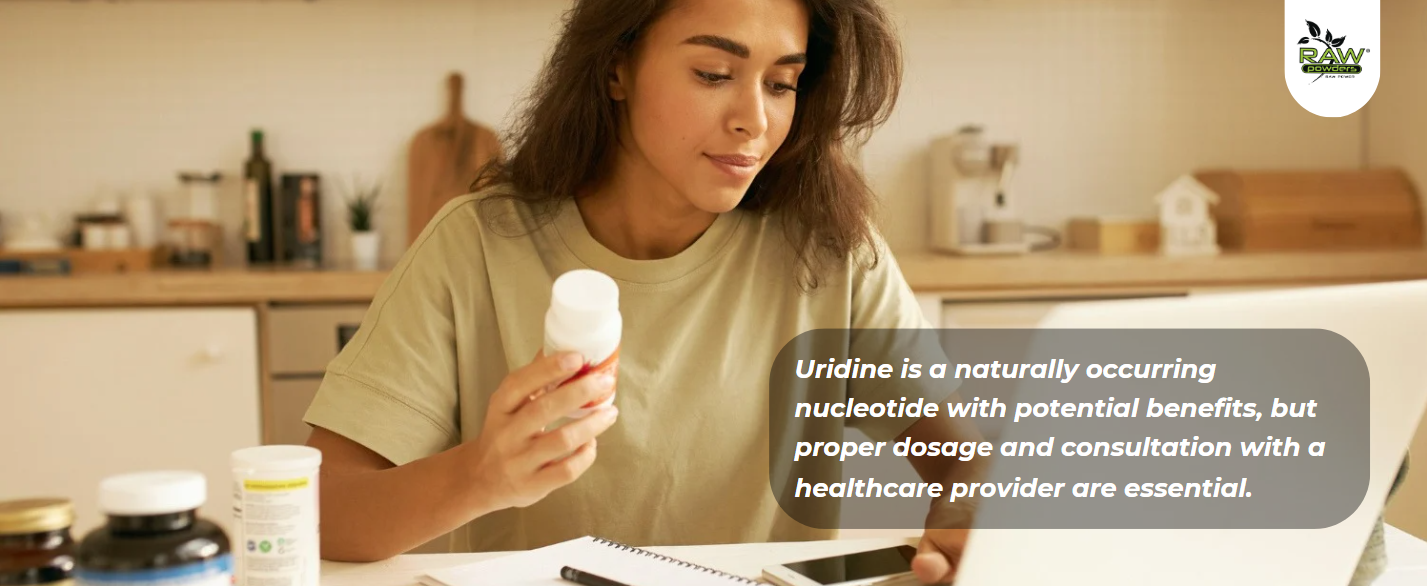
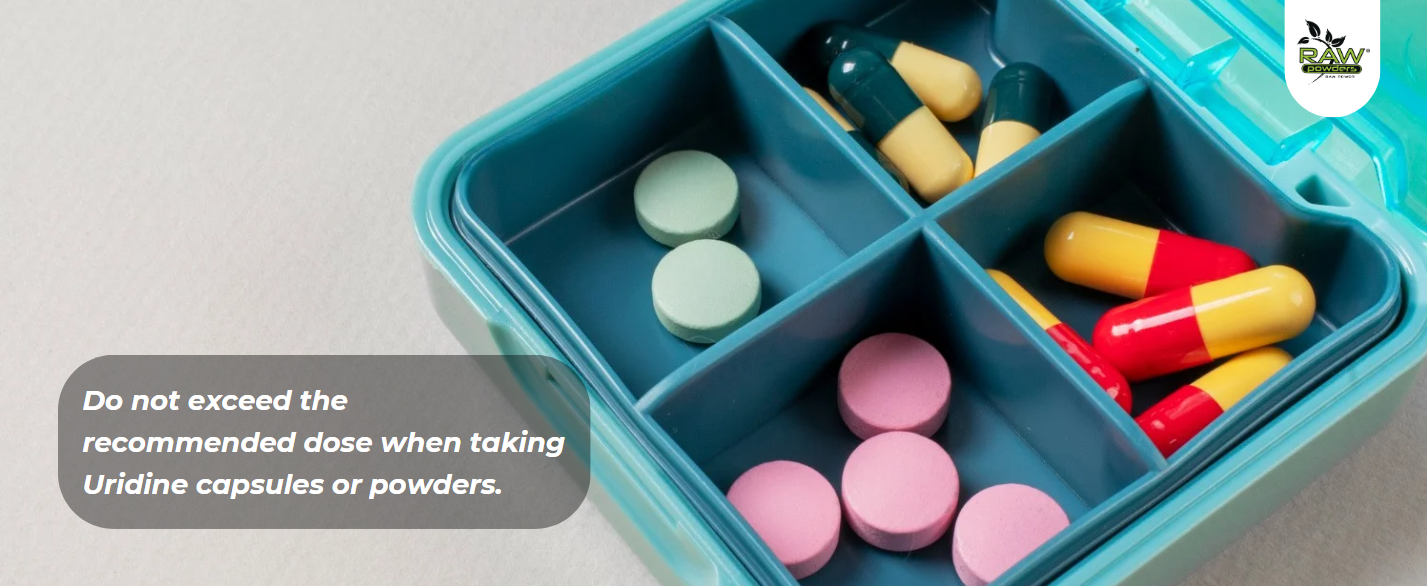
_front%20(1)-min-250x250.png)

